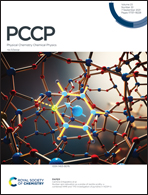Replacing the cyano (–C![[triple bond, length as m-dash]](https://www.rsc.org/images/entities/char_e002.gif) N) group to design environmentally friendly fused-ring electron acceptors†
N) group to design environmentally friendly fused-ring electron acceptors†
Abstract
The cyano-group (–C![[triple bond, length as m-dash]](https://www.rsc.org/images/entities/char_e002.gif) N) is an electron-withdrawing group, which has been widely used to construct high-performance fused-ring electron acceptors (FREAs). Benefiting from these FREAs, the power conversion efficiency of organic solar cells has recently exceeded 18%. However, malononitrile is a highly toxic substance used to introduce –C
N) is an electron-withdrawing group, which has been widely used to construct high-performance fused-ring electron acceptors (FREAs). Benefiting from these FREAs, the power conversion efficiency of organic solar cells has recently exceeded 18%. However, malononitrile is a highly toxic substance used to introduce –C![[triple bond, length as m-dash]](https://www.rsc.org/images/entities/char_e002.gif) N during the synthesis of these FREAs. Therefore, the synthesis processes of most high-performance FREAs are typically harmful to the environment. Our previous work demonstrated that the electron-withdrawing ability of –C
N during the synthesis of these FREAs. Therefore, the synthesis processes of most high-performance FREAs are typically harmful to the environment. Our previous work demonstrated that the electron-withdrawing ability of –C![[triple bond, length as m-dash]](https://www.rsc.org/images/entities/char_e002.gif) N is necessary for FREAs. Thus, the use of other electron-withdrawing groups instead of –C
N is necessary for FREAs. Thus, the use of other electron-withdrawing groups instead of –C![[triple bond, length as m-dash]](https://www.rsc.org/images/entities/char_e002.gif) N to design environmentally friendly FREAs is feasible. We utilized seven electron-withdrawing groups, namely, –C
N to design environmentally friendly FREAs is feasible. We utilized seven electron-withdrawing groups, namely, –C![[double bond, length as m-dash]](https://www.rsc.org/images/entities/char_e001.gif) NH, –N
NH, –N![[double bond, length as m-dash]](https://www.rsc.org/images/entities/char_e001.gif) O, –CH
O, –CH![[double bond, length as m-dash]](https://www.rsc.org/images/entities/char_e001.gif) O, –CO–CH3, –CO–OH, –CO–Cl, and –CO–Br, to replace –C
O, –CO–CH3, –CO–OH, –CO–Cl, and –CO–Br, to replace –C![[triple bond, length as m-dash]](https://www.rsc.org/images/entities/char_e002.gif) N in the commonly used acceptor Y6 to design new FREAs (Y6-CNH, Y6-NO, Y6-CHO, Y6-COCH3, Y6-COOH, Y6-COCl, and Y6-COBr). Multi-scale theoretical calculation methods were used to investigate the photoelectronic properties of these new FREAs, including energy level, absorption spectrum, exciton binding energy, and electron mobility. The results showed that Y6-CNH, Y6-COCH3 and Y6-COOH are unsuitable for use as acceptor materials because of their high frontier molecular orbital energy level and weak electron affinity. The strong absorption intensity and weak exciton binding energy of Y6-CHO, Y6-COCl, and Y6-COBr indicated that they can absorb more solar energy than Y6 and excitons are easier to separate into free charges. The electron mobility of Y6-CHO (3.53 × 10−4 cm2 V−1 s−1) was found to be approximately 28 times that of Y6-COCl (1.24 × 10−5 cm2 V−1 s−1) and Y6-COBr (1.28 × 10−5 cm2 V−1 s−1). The possible synthetic routes to Y6-CHO are environmentally friendly. Therefore, –CH
N in the commonly used acceptor Y6 to design new FREAs (Y6-CNH, Y6-NO, Y6-CHO, Y6-COCH3, Y6-COOH, Y6-COCl, and Y6-COBr). Multi-scale theoretical calculation methods were used to investigate the photoelectronic properties of these new FREAs, including energy level, absorption spectrum, exciton binding energy, and electron mobility. The results showed that Y6-CNH, Y6-COCH3 and Y6-COOH are unsuitable for use as acceptor materials because of their high frontier molecular orbital energy level and weak electron affinity. The strong absorption intensity and weak exciton binding energy of Y6-CHO, Y6-COCl, and Y6-COBr indicated that they can absorb more solar energy than Y6 and excitons are easier to separate into free charges. The electron mobility of Y6-CHO (3.53 × 10−4 cm2 V−1 s−1) was found to be approximately 28 times that of Y6-COCl (1.24 × 10−5 cm2 V−1 s−1) and Y6-COBr (1.28 × 10−5 cm2 V−1 s−1). The possible synthetic routes to Y6-CHO are environmentally friendly. Therefore, –CH![[double bond, length as m-dash]](https://www.rsc.org/images/entities/char_e001.gif) O is the most suitable electron-withdrawing group for constructing high-performance environmentally friendly FREAs. This work can provide a new molecular design perspective in experimental science for developing high-performance environmentally friendly FREAs.
O is the most suitable electron-withdrawing group for constructing high-performance environmentally friendly FREAs. This work can provide a new molecular design perspective in experimental science for developing high-performance environmentally friendly FREAs.
![Graphical abstract: Replacing the cyano (–C [[triple bond, length as m-dash]] N) group to design environmentally friendly fused-ring electron acceptors](/en/Image/Get?imageInfo.ImageType=GA&imageInfo.ImageIdentifier.ManuscriptID=D1CP02566J&imageInfo.ImageIdentifier.Year=2021)


 Please wait while we load your content...
Please wait while we load your content...
![[triple bond, length as m-dash]](https://www.rsc.org/images/entities/h2_char_e002.gif) N) group to design environmentally friendly fused-ring electron acceptors
N) group to design environmentally friendly fused-ring electron acceptors